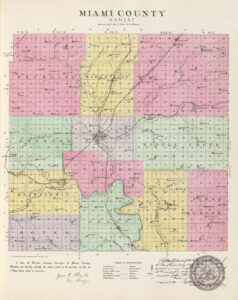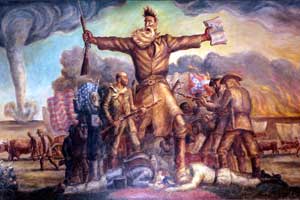One of the oldest towns in Miami County, Kansas, Stanton, was located on the Marais des Cygnes River, about seven miles northwest of Osawatomie, near the county’s western boundary.
It was founded in the summer of 1855 by H. B. Standford, and named Stanton, in honor of Captain Standford. Among the earliest settlers in the vicinity were S. H. Houser, Dr. Winans, B. E. Briant, C. B. Tipton, Charles Rice, and others.
A post office was established on June 8, 1857, with Mr. Ward appointed postmaster. He opened a store the same year. A. Housemen erected a steam sawmill in 1857. During the year, Captain Standford sold the town’s land to an Indiana company, of which E. P. Hicks was president and J. B. Hobson was secretary. I.V. Beeson resurveyed and platted the town site for them.
It was an important village during the Kansas-Missouri Border War.
One noted character who settled early near Stanton was Reverend Martin White, who came to Kansas from Christian County, Illinois. He was a well-educated Baptist minister and one of the most extreme pro-slavery men. John Brown, Sr., made an abolition speech at a meeting on April 16, 1856, at which resolutions were adopted against paying taxes. While Brown was talking, Reverend White offensively interrupted him several times.
As Reverend White was exceedingly obnoxious to the Free State men, a few nights after the meeting occurred, 12 of them attacked his house, opening fire on it. Those inside vigorously replied to the firing. The attacking party soon retired, taking White’s horses with them. The next day, White moved to Missouri settling permanently in Bates County. After serving in the Confederate army through the war, Mr. White returned to his home in Bates County and died of wounds received in the service.
The year 1860 was a year of drought. During the previous winter, there was very little rain or snowfall. Light snow fell in February, after which there was neither snow nor rain until June 6, when a light rain fell, preceded by a heavy wind. The high wind became a cyclone as it passed over Stanton, Indianapolis, and Osawatomie. The residence of D.C. Baker was blown down, and he, Newell Kinkaid, and another person were killed. The Masonic Lodge was also carried away, and the records, regalia, and fixtures were destroyed. Mr. Holladay’s house was blown away in Indianapolis, and Mrs. Holladay was killed. At Osawatomie, the brick residence of Mrs. Coleman was blown down, but no one was injured.
No rain fell during the subsequent months, and the heat became almost intolerable. The crops on the uplands failed; few farmers had supplies to meet their necessities, but faithful friends in the East furnished assistance, and afterward, the county was free from severe drought.
Stanton had a sawmill, several stores, a blacksmith shop, etc., and about 100 inhabitants at the height of its prosperity. However, by the early 1880s, its population had fallen to just about 25. Afterward, the community grew some, but its post office closed on November 14, 1903. In 1910 Stanton had a population of 160.
© Kathy Alexander/Legends of Kansas, updated March 2023.
Also See:


